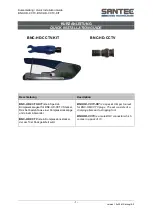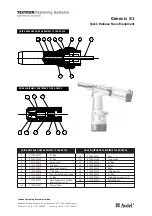
manufactured well and safely.
- Do not use a power tool that cannot be safely switched on and off with the control switch. The use of such
tools is dangerous. A damaged circuit breaker must be repaired by a certified service center.
- Disconnect the tool from the mains before carrying out any adjustment, replacement or maintenance. This
measure will reduce the risk of accidental starting.
- Keep unused power tools out of the reach of children and unauthorized persons. Power tools used by
inexperienced users can be dangerous. Store power tools in a dry and safe place.
- Carefully keep the power tool in good condition. Regularly check the setting of moving parts and their
mobility. Inspect the protective covers or other parts for damage to the safe operation of the power tool. If
the tool is damaged, have it repaired before using it again. Many injuries are caused by improper
maintenance of the power tool.
- Keep cutting tools sharp and clean. Properly maintained and sharpened tools make work easier, reduce the
risk of injury and work with them is better controlled. Use of accessories other than those specified in the
operating instructions or recommended by the importer may damage the tool and cause injury.
- Power tools, accessories, work tools, etc. use in accordance with these instructions and in the manner
prescribed for the particular power tool, taking into account the working conditions and the type of work
performed. Using the tool for purposes other than those for which it is intended can lead to dangerous
situations.
5) USING THE BATTERY TOOL
- Before inserting the battery, make sure that the switch is in the "0-off" position. Inserting the battery into
a switched-on tool can cause dangerous situations.
- Use only the chargers specified by the manufacturer to charge the battery. Using the charger for another
type of battery may damage it and cause a fire.
- Only use batteries designed for the tool. Use of other batteries may result in injury or fire.
- When the battery is not in use, keep it away from metal objects such as terminals, wrenches, screws and
other small metal objects that could cause one battery contact to come into contact with another. Short-
circuiting the battery may result in injury, burns, or fire.
- Handle batteries carefully. If handled carelessly, a chemical may leak from the battery. Avoid contact with
her. If contact with this chemical nevertheless occurs, wash the affected area with running water. In case of
contact with eyes, seek medical advice immediately. Battery chemical can cause serious injury.
- The battery or tool must not be exposed to fire or excessive heat. Exposure to fire or temperature above
130°C may cause an explosion.
- The battery or tool that is damaged or rebuilt must not be used. Damaged or modified batteries can behave
unpredictably, causing fire, explosion, or injury.
6) SERVICE
- Have a power tool serviced by a qualified repair person. Only the same spare parts may be used. This will
ensure that the safety of the power tool is maintained.
SAFETY INSTRUCTIONS FOR BATTERY AND CHARGER
- Read the operating instructions carefully before using the battery and charger for the first time.
1. Verify that the power available on your network is the one indicated on the battery charger.
2. Do not allow moisture, rain or splash water to reach the battery charging station.
3. Do not charge the battery when the temperature is below 10°C or above 40°C. Charging the battery in
extreme temperatures may shorten its life.
4. A damaged battery that can no longer be charged must be treated as hazardous waste. Do not dispose of
the battery in trash, fire or water.
5. Use only batteries and chargers approved by the manufacturer for use with this device.
6. Keep the charger clean, free of dust and dirt.
7. Always remove the battery before repairing the device.
8. Cover the battery contacts to prevent a short circuit.






































